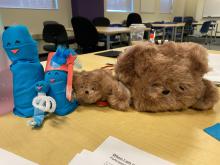Haptic Robot Animacy and Behaviour
Investigating the design process of expressive affective haptic robot behaviors

Investigating the design process of expressive affective haptic robot behaviors

Inspired by needs for haptic support of large motions on a surface (in embodied conceptual learning, commercial design, and 2D virtual / augmented reality), we present the ballpoint drive. This novel approach circumvents conventional constraints by imposing a new one: motion restricted to rolling on an arbitrary two dimensional surface, and grounding forces generated through friction.

Educational haptic platforms can leverage various modalities in order create effective interactive environments that can support embodied physical interactions. These platforms have the potential to leverage a student’s physical intuition to make abstract topics in physics, math, and other fields of science more concrete.

Creating a community for experienced hapticians and newcomers to learn, share, and explore haptic resources and projects, and investigating the challenges involved in haptic experience design for both newcomers and experienced hapticians.

Haptipedia is a comprehensive library of haptic devices annotated with designer-relevant metadata, then accessed through an interactive visualization to assist designers in finding relevant design examples.

MacaronMix is an online, open-source tool for morphing haptic signals. Designers, researchers, and hapticians can use this tool to create and study haptic icons, and to develop new morphing algorithms. Link: http://hapticdesign.github.io/macaronmix/

People describe vibrations using emotional descriptions. For example, signals can feel more or less "lively" than others. Can this language be used to stylize vibrations to feel more/less along certain emotional dimensions?

Voodle is an interface that uses vocal input to design haptic behaviour.
Macaron is a free, open-source, online haptic editor. Designed to be an easy-to-use tool for anyone working with haptics, it is a platform for experimenting with new haptic design features and has helped us understand how examples aid the haptic design process.

Embodied, physical interaction can improve learning by making abstractions concrete. We use DIY haptic devices to move hands-on learning online.
